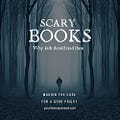I’m often asked why I write scary books for children, filled with ghosts and evil trees and cursed lockets. Whenever the question crops up, I like to counter with my own question: “What was your favourite children’s book growing up?”
Usually the parent/guardian/teacher/journalist in front of me comes back with a classic.
Charlie and the Chocolate Factory.
And that’s when I like to remind them that Peter Rabbit spends his days being hunted by Mr McGregor (Peter’s dad ended up in a pie!).
Augustus Gloop got sucked up a pipe, Violet Beauregarde was turned into a giant blueberry, and Veruca Salt was hurled down a garbage chute.
The Secret Garden starts with us being introduced to a neglected, unloved child whose parents swiftly die of cholera, the servants of the house abandoning her until finally she is discovered by soldiers and shipped off to an unknown relative in England.
That’s right, my friends, The Secret Garden is not a story about a pretty petunias.
“Oh!” the parent/guardian/teacher/journalist will invariably say. “I don’t remember that bit at all in The Secret Garden.”
(This actually horrifies me as that is the best bit in The Secret Garden and, let’s face it, my deep and abiding love for it most likely explains why I write scary books for children, filled with ghosts and evil trees and cursed lockets.)
I find reminding people about the plots of these beloved classics such an interesting exercise, because I think adults look back on childhood itself with rose-coloured glasses, seeing it as a carefree time of play and laughter. But the truth is, childhood can be very scary indeed.
We are small. We are vulnerable. There’s a lot we don’t know. Don’t understand. We’re trying to work out how the world works. We’re weighing things up. Working out what’s right and what’s wrong. Who we can trust. Who is unreliable.
It's a tough time.
But what we read can help.
Keep reading with a 7-day free trial
Subscribe to Your Kid's Next Read to keep reading this post and get 7 days of free access to the full post archives.



